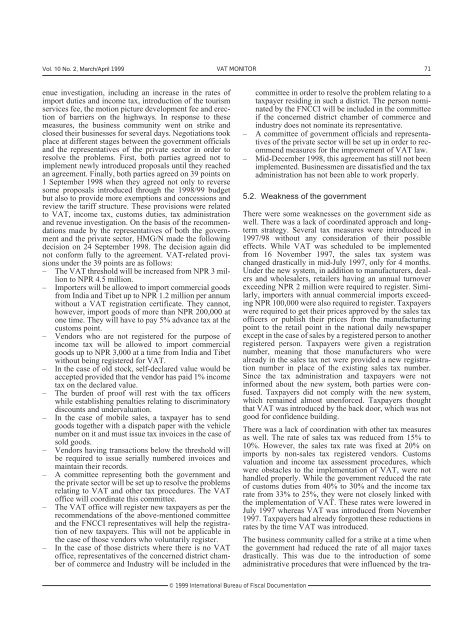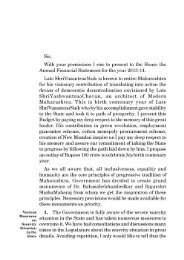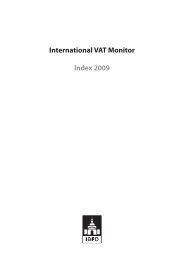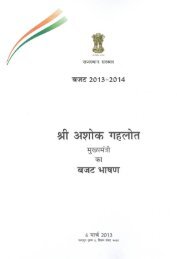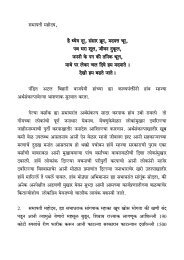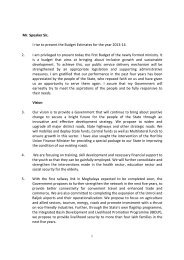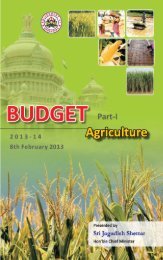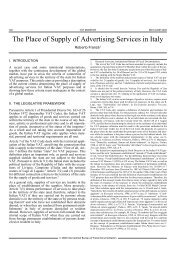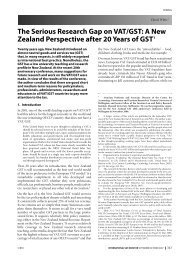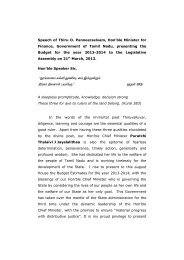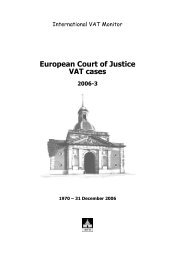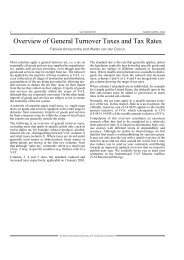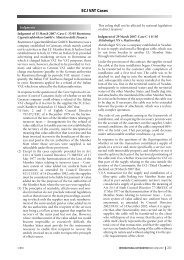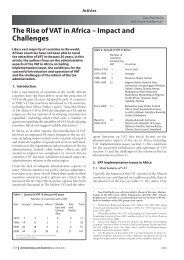VAT 99-2/final - empcom.gov.in
VAT 99-2/final - empcom.gov.in
VAT 99-2/final - empcom.gov.in
Create successful ePaper yourself
Turn your PDF publications into a flip-book with our unique Google optimized e-Paper software.
Vol. 10 No. 2, March/April 1<strong>99</strong>9 <strong>VAT</strong> MONITOR 71<br />
enue <strong>in</strong>vestigation, <strong>in</strong>clud<strong>in</strong>g an <strong>in</strong>crease <strong>in</strong> the rates of<br />
import duties and <strong>in</strong>come tax, <strong>in</strong>troduction of the tourism<br />
services fee, the motion picture development fee and erection<br />
of barriers on the highways. In response to these<br />
measures, the bus<strong>in</strong>ess community went on strike and<br />
closed their bus<strong>in</strong>esses for several days. Negotiations took<br />
place at different stages between the <strong>gov</strong>ernment officials<br />
and the representatives of the private sector <strong>in</strong> order to<br />
resolve the problems. First, both parties agreed not to<br />
implement newly <strong>in</strong>troduced proposals until they reached<br />
an agreement. F<strong>in</strong>ally, both parties agreed on 39 po<strong>in</strong>ts on<br />
1 September 1<strong>99</strong>8 when they agreed not only to reverse<br />
some proposals <strong>in</strong>troduced through the 1<strong>99</strong>8/<strong>99</strong> budget<br />
but also to provide more exemptions and concessions and<br />
review the tariff structure. These provisions were related<br />
to <strong>VAT</strong>, <strong>in</strong>come tax, customs duties, tax adm<strong>in</strong>istration<br />
and revenue <strong>in</strong>vestigation. On the basis of the recommendations<br />
made by the representatives of both the <strong>gov</strong>ernment<br />
and the private sector, HMG/N made the follow<strong>in</strong>g<br />
decision on 24 September 1<strong>99</strong>8. The decision aga<strong>in</strong> did<br />
not conform fully to the agreement. <strong>VAT</strong>-related provisions<br />
under the 39 po<strong>in</strong>ts are as follows:<br />
– The <strong>VAT</strong> threshold will be <strong>in</strong>creased from NPR 3 million<br />
to NPR 4.5 million.<br />
– Importers will be allowed to import commercial goods<br />
from India and Tibet up to NPR 1.2 million per annum<br />
without a <strong>VAT</strong> registration certificate. They cannot,<br />
however, import goods of more than NPR 200,000 at<br />
one time. They will have to pay 5% advance tax at the<br />
customs po<strong>in</strong>t.<br />
– Vendors who are not registered for the purpose of<br />
<strong>in</strong>come tax will be allowed to import commercial<br />
goods up to NPR 3,000 at a time from India and Tibet<br />
without be<strong>in</strong>g registered for <strong>VAT</strong>.<br />
– In the case of old stock, self-declared value would be<br />
accepted provided that the vendor has paid 1% <strong>in</strong>come<br />
tax on the declared value.<br />
– The burden of proof will rest with the tax officers<br />
while establish<strong>in</strong>g penalties relat<strong>in</strong>g to discrim<strong>in</strong>atory<br />
discounts and undervaluation.<br />
– In the case of mobile sales, a taxpayer has to send<br />
goods together with a dispatch paper with the vehicle<br />
number on it and must issue tax <strong>in</strong>voices <strong>in</strong> the case of<br />
sold goods.<br />
– Vendors hav<strong>in</strong>g transactions below the threshold will<br />
be required to issue serially numbered <strong>in</strong>voices and<br />
ma<strong>in</strong>ta<strong>in</strong> their records.<br />
– A committee represent<strong>in</strong>g both the <strong>gov</strong>ernment and<br />
the private sector will be set up to resolve the problems<br />
relat<strong>in</strong>g to <strong>VAT</strong> and other tax procedures. The <strong>VAT</strong><br />
office will coord<strong>in</strong>ate this committee.<br />
– The <strong>VAT</strong> office will register new taxpayers as per the<br />
recommendations of the above-mentioned committee<br />
and the FNCCI representatives will help the registration<br />
of new taxpayers. This will not be applicable <strong>in</strong><br />
the case of those vendors who voluntarily register.<br />
– In the case of those districts where there is no <strong>VAT</strong><br />
office, representatives of the concerned district chamber<br />
of commerce and Industry will be <strong>in</strong>cluded <strong>in</strong> the<br />
committee <strong>in</strong> order to resolve the problem relat<strong>in</strong>g to a<br />
taxpayer resid<strong>in</strong>g <strong>in</strong> such a district. The person nom<strong>in</strong>ated<br />
by the FNCCI will be <strong>in</strong>cluded <strong>in</strong> the committee<br />
if the concerned district chamber of commerce and<br />
<strong>in</strong>dustry does not nom<strong>in</strong>ate its representative.<br />
– A committee of <strong>gov</strong>ernment officials and representatives<br />
of the private sector will be set up <strong>in</strong> order to recommend<br />
measures for the improvement of <strong>VAT</strong> law.<br />
– Mid-December 1<strong>99</strong>8, this agreement has still not been<br />
implemented. Bus<strong>in</strong>essmen are dissatisfied and the tax<br />
adm<strong>in</strong>istration has not been able to work properly.<br />
5.2. Weakness of the <strong>gov</strong>ernment<br />
© 1<strong>99</strong>9 International Bureau of Fiscal Documentation<br />
There were some weaknesses on the <strong>gov</strong>ernment side as<br />
well. There was a lack of coord<strong>in</strong>ated approach and longterm<br />
strategy. Several tax measures were <strong>in</strong>troduced <strong>in</strong><br />
1<strong>99</strong>7/98 without any consideration of their possible<br />
effects. While <strong>VAT</strong> was scheduled to be implemented<br />
from 16 November 1<strong>99</strong>7, the sales tax system was<br />
changed drastically <strong>in</strong> mid-July 1<strong>99</strong>7, only for 4 months.<br />
Under the new system, <strong>in</strong> addition to manufacturers, dealers<br />
and wholesalers, retailers hav<strong>in</strong>g an annual turnover<br />
exceed<strong>in</strong>g NPR 2 million were required to register. Similarly,<br />
importers with annual commercial imports exceed<strong>in</strong>g<br />
NPR 100,000 were also required to register. Taxpayers<br />
were required to get their prices approved by the sales tax<br />
officers or publish their prices from the manufactur<strong>in</strong>g<br />
po<strong>in</strong>t to the retail po<strong>in</strong>t <strong>in</strong> the national daily newspaper<br />
except <strong>in</strong> the case of sales by a registered person to another<br />
registered person. Taxpayers were given a registration<br />
number, mean<strong>in</strong>g that those manufacturers who were<br />
already <strong>in</strong> the sales tax net were provided a new registration<br />
number <strong>in</strong> place of the exist<strong>in</strong>g sales tax number.<br />
S<strong>in</strong>ce the tax adm<strong>in</strong>istration and taxpayers were not<br />
<strong>in</strong>formed about the new system, both parties were confused.<br />
Taxpayers did not comply with the new system,<br />
which rema<strong>in</strong>ed almost unenforced. Taxpayers thought<br />
that <strong>VAT</strong> was <strong>in</strong>troduced by the back door, which was not<br />
good for confidence build<strong>in</strong>g.<br />
There was a lack of coord<strong>in</strong>ation with other tax measures<br />
as well. The rate of sales tax was reduced from 15% to<br />
10%. However, the sales tax rate was fixed at 20% on<br />
imports by non-sales tax registered vendors. Customs<br />
valuation and <strong>in</strong>come tax assessment procedures, which<br />
were obstacles to the implementation of <strong>VAT</strong>, were not<br />
handled properly. While the <strong>gov</strong>ernment reduced the rate<br />
of customs duties from 40% to 30% and the <strong>in</strong>come tax<br />
rate from 33% to 25%, they were not closely l<strong>in</strong>ked with<br />
the implementation of <strong>VAT</strong>. These rates were lowered <strong>in</strong><br />
July 1<strong>99</strong>7 whereas <strong>VAT</strong> was <strong>in</strong>troduced from November<br />
1<strong>99</strong>7. Taxpayers had already forgotten these reductions <strong>in</strong><br />
rates by the time <strong>VAT</strong> was <strong>in</strong>troduced.<br />
The bus<strong>in</strong>ess community called for a strike at a time when<br />
the <strong>gov</strong>ernment had reduced the rate of all major taxes<br />
drastically. This was due to the <strong>in</strong>troduction of some<br />
adm<strong>in</strong>istrative procedures that were <strong>in</strong>fluenced by the tra-


